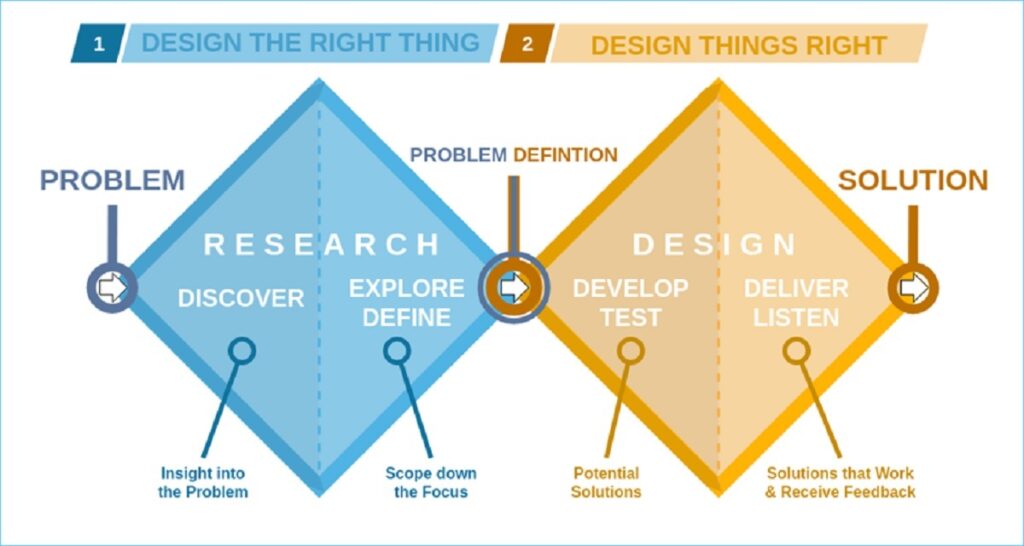The first step in the human-centered design study is to obtain a thorough knowledge of people and the problems that the product is meant to address. Various businesses, groups, and academic institutions have taken up this problem and developed frameworks to help organize the human-centered design process.
In this article, we’ll see how to use the Double diamond framework to apply design thinking, HCD, UX, or any creative process.
Point A to Point B
In nearly any innovative or design endeavor, the central question is how to go from point A – “I don’t know” – to point B – “I do know”. At first glance, this procedure appears to be simple and uncomplicated. In truth, it’s a never-ending cycle, as innovation is ever-evolving.
The Double Diamond is a four-phased design technique for tackling issues:
- Discover: understanding the issue
- Define: the region to concentrate on
- Develop: potential solutions
- Deliver: workable solutions
Point A to Point B phase includes two sub-phases: divergence and convergence. You strive to expand your findings as much as possible without restricting yourself throughout a diverging phase, whereas a converging phase focuses on compressing and limiting your discoveries or thoughts.
The four steps of the Double Diamond method may be streamlined and combined into two primary stages:
- Stage 1 (Diamond 1 — Discover and Define): Before you attempt anything, be sure you have the proper solution to deal with or the correct question to ask. It all comes down to what you do.
- Stage 2 (Diamond 2 — Develop and Deliver): Once you’ve figured out what questions to address or which problems to solve, you’ll want to do it correctly. It’s about how you go about doing it.
Stage 1 (Diamond 1 — Discover and Define):
Discover:
Challenge the brief or your original inquiry by assessing topics of interest and questioning every element of it. List as many of the components as possible, look for traits, designate regions of interest and extremities, and make a list of relevant locations, people, and experiences that may be investigated. Before you begin your study, group your results into themes to obtain a better perspective, and you may need to limit the scope of your investigation. Field and desk research methods should be used.
As a result, you should have a large stack of unstructured study findings.
Define:
All of your research should be summarized and shared with your team. Lessons learned in clusters and themes that are related. Finding insights and creating opportunity areas can help decrease the data usability gap.
As a result, you should draft a new brief that either explains or elaborates on the original short challenge and even opposes it.
Stage 2 (Diamond 2 — Develop and Deliver):
Develop:
- Ideation: It’s in the middle of a divergent phase. You must avoid setting boundaries for yourself and embrace brainstorming with an open mind. At this stage, anything may happen, and you can expand on someone else’s ideas. There are several tools and ways for generating creative ideas.
- Evaluation: Assess your thoughts after an ideation period and choose your favorites. Dot voting and impact/feasibility matrices are various tools that come in handy.
As a consequence of this step, you should try to come up with a few thoughts that you wish to develop and test afterward.
Deliver:
After you’ve come up with a few viable solutions (ideas), you’ll want to assess the best one and how it should be implemented. To do so, you can use the three-step agile method:
- Build
- Test
- Repeat
After you’ve done that, you might want to go back to the beginning and do it all over again since there’s always room for improvement.
Conclusion
This revamped Double Diamond is only ONE method. The shape of the diamonds can vary based on the job and the assignment. For example, there may be tasks or initiatives in which you concentrate exclusively on one aspect of the Double Diamond. Furthermore, this is not a linear process, and in actuality, you must be flexible and willing to switch gears at any time. This article also concentrates on the application’s overall structure instead of all of the tools and approaches that may be used to improve it.
FAQ
- What is UX?
Ans. User experience, or UX, refers to anything that happens to a user while engaging with a brand, service, or knowledge. The practice of changing this experience via study, research, and layout of the interactions engaged in a system is known as user experience design.
- Is Revamped Double diamond the only framework for effective design?
Ans. This reworked Double Diamond is simply ONE method. It’s not the only method, and it’s meant to be tested, debated, and improved upon. It is a framework that anyone can use or not use.








Leave a Comment
You must be logged in to post a comment.